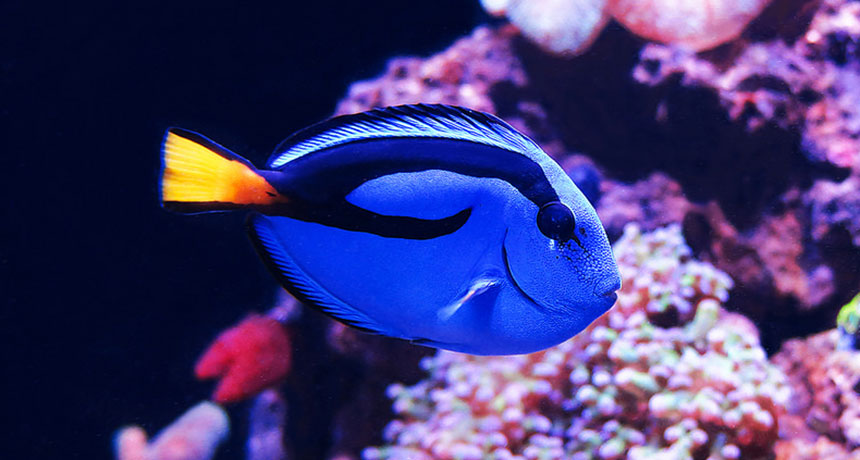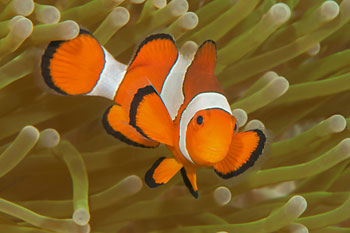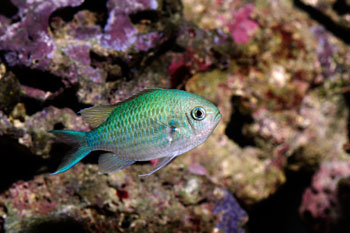Catching ‘Dory’ fish can poison entire coral reef ecosystems
Blue tangs and other popular saltwater-aquarium fish often are caught using cyanide

Every “Dory” sold in shops was caught from the wild. And there’s a high likelihood it was caught using a dangerous poison, new research shows.
Stéphane Duquesne/Flickr (CC-BY-NC 2.0)
The popularity of animated kids’ movies — Finding Nemo and its new sequel, Finding Dory — could spell doom for many coral reef communities, a new study warns. But even without families trying to bring home the types of fish portrayed in these films, coral-reef species are in trouble. The aquarium industry has been harvesting fish as pets. And more than half of the saltwater fish sold as U.S. pets may have been caught with a deadly poison — cyanide. That is the finding of a new study.
Many kids fell in love with orange-and-white clownfish after watching the 2003 classic Finding Nemo. Its namesake was one of these fish. Owing to the movie’s popularity, many parents bought kids their own Nemo. People purchased so many Nemos that some wild communities of the fish plummeted in number.
Now there are worries that a new movie out this week, Finding Dory, may have a similar effect on Dory’s species, the blue tang.

For those who supply pet-shop fish, cyanide is “cheap and easy” wayto catch them, notes Craig Downs. He directs the Haereticus Environmental Laboratory in Clifford, Va. A diver simply adds a pellet of cyanide to a bottle and squirts a bit on a target fish. Or someone may pump larger quantities down from a boat. The poison quickly stuns the fish, Downs explains. It then can be captured and later sold.
But cyanide is deadly. Coral exposed to cyanide can bleach and die. Non-targeted fish and other organisms left behind also can die. Even the fish caught for sale in pet shops may die within a few weeks or months after the cyanide treatment.
“If you survive [exposure], you’re messed up for the rest of your life,” Downs says. There are laws that should prevent divers from using the cyanide-stun method to capture fish. And animals caught this way are not supposed to be allowed into the United States for sale. But “this practice happens all through the Indo-Pacific,” says Downs. (That’s a term for waters of the Indian and Pacific Oceans.) As many as 30 million fish may be caught this way every year, Downs says. Of those, some 27 million may die.
How they know cyanide had been used
There is no way for someone purchasing a fish in a pet store to tell if the animal had been exposed to cyanide. “You have to be a fish pathologist” to see the signs, Downs says. But after being exposed to the poison, a fish’s body turns it into another chemical. This is thiocyanate (THY-oh-SY-uh-nayt). The fish will excrete the new chemical in its urine. Experts can detect residues of the thiocyanate in the water.
Downs works with Rene Umberger. She is director of For the Fishes. This conservation group works to protect fish and coral reefs from the aquarium trade. Recently, the pair wanted to get an idea of how many of the fish sold in pet stores may have been caught using cyanide. They purchased 89 fish from shops in California, Hawaii, Maryland, North Carolina and Virginia. Then they collected samples of the water in which each fish had been swimming. This water contained the fish’s pee.

The pair also obtained some fish from companies that breed fish in captivity. (In other words, these fish were never in the wild.) None of those fish excreted thiocyanate. This confirms that only wild-caught fish had been exposed to cyanide.
The researchers will present these results later this month at the International Coral Reef Symposium in Hawaii.
Cyanide stunning is very common
Most of the 11 million saltwater fish sold in the U.S. aquarium trade come from coral reefs in the Indo-Pacific. In some places, such as Hawaii and Australia, there are laws about catching these fish. These countries can be quite protective of the environment. And there often is good government enforcement of their laws. As a result, their local fish can be collected without too much harm.
But in many places, few laws exist. Or there may not be enough enforcers to police those laws (or ensure that they are followed). In these places, fish collectors may use quick, inexpensive — but very destructive — practices, such as cyanide.
A 2008 report by the National Oceanic and Atmospheric Administration estimated that 90 percent of the saltwater aquarium fish imported into the United States had been captured with cyanide or other illegal methods. Downs suspects that the true numbers for his fish are higher than he and his colleague are now reporting.
Here’s why. Fish excrete detectable levels of thiocyanate for only a short time. So if their pee is not tested quickly enough, any evidence that they had been poisoned might disappear.
And there’s another sign that his team’s new data may underestimate cyanide exposures in imported fish. Downs’ team has developed a new, more sensitive method for detecting cyanide exposure. The initial results using it, Downs says, show that many more fish may have been exposed than the first method that he had used showed.
Buying Dory — blue tangs — was never a good idea. The fish come from the wild. And they require a lot of upkeep. But the new evidence shows that the way these fish are caught harms not only them but also the coral reefs in which they had lived.
Still, this doesn’t mean that people should stop buying all saltwater fish, Downs says. “If consumers really want to have coral-reef fish, then [try] going the cultured route,” Downs says. By cultured, he means seek out fish that had been raised in captivity — not collected in the wild.
More than 1,800 species enter the U.S. aquarium trade each year. Only around 40 are captive-bred. That may not be many, but identifying them is easy. Umberger’s group released a free app for Apple devices called Tank Watch. This app lists them all. The app doesn’t list every species that may be in a store. But if a species isn’t on the good list, buyers can assume it is coming from the wild using a harmful technique.
Better yet, Downs argues, is simply to travel to where these fish live and “visit the fish there.”







